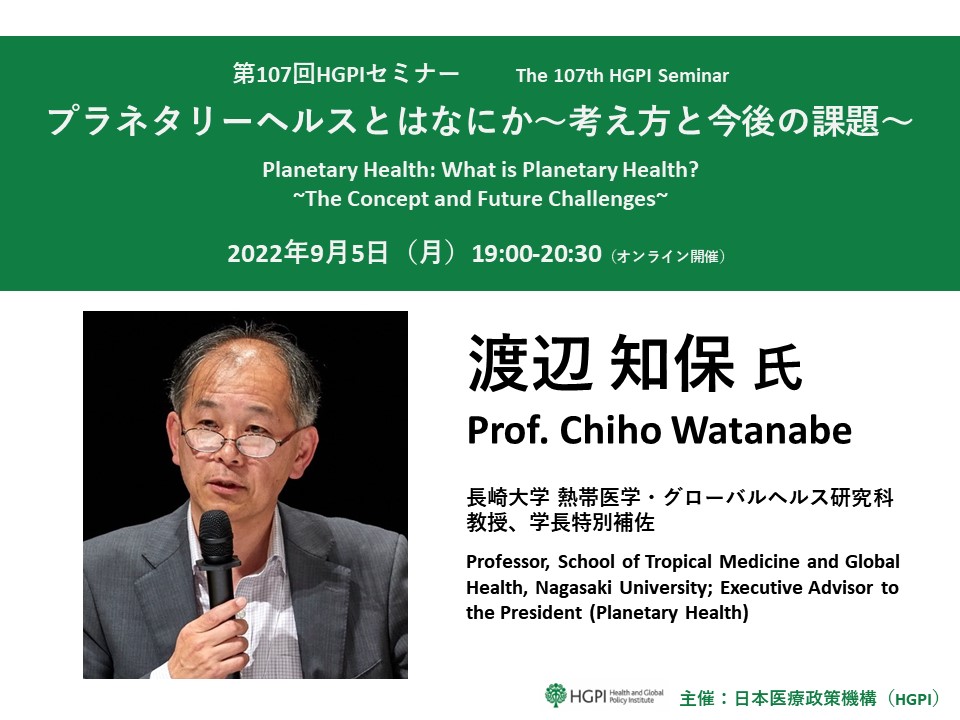[Event Report] The 106th HGPI Seminar – The Construction of COVID-19 Vaccination Management Systems and Information Sharing in the Future (August 5, 2022)
date : 10/25/2022
Tags: HGPI Seminar, Vaccinations
![[Event Report] The 106th HGPI Seminar – The Construction of COVID-19 Vaccination Management Systems and Information Sharing in the Future (August 5, 2022)](https://hgpi.org/en/wp-content/uploads/sites/2/hs106-top-1.jpg)
At the 106th HGPI Seminar, we hosted Mr. Mizuho Oyama, Deputy Director of the Planning and Finance Department and Director of the Digital Strategy Office (CDO) of Toda City and Regional Informatization Advisor to the Ministry of Internal Affairs and Communications. Toda City was one of the first cities that established an advanced vaccination information system during the COVID-19 pandemic.
In response to the ongoing COVID-19 pandemic, Toda City developed a new system for linking COVID-19 vaccination records called T-SYS, which has become an effective tool for visualizing vaccination progress and promoting vaccinations. In addition to Toda City’s innovative efforts, this HGPI seminar covered various topics from the perspective of local governments, including how to apply best practices developed in response to the pandemic during non-emergencies, how to link multiple information systems including those for vaccination, medical, and health information, the roles of the national and local governments in building a data infrastructure, and how those parties should collaborate.
<Key points of the lecture>
- To facilitate the deployment of COVID-19 vaccines, the Digital Agency built a system for registering vaccinations on a national scale called the Vaccination Record System (VRS). The VRS allows each municipality to register vaccination information in near real-time. However, it does not offer the feature to record adverse effects.
- When Toda City was notified of the development of the VRS, it developed the Toda City COVID-19 Vaccination Record Linkage System (T-SYS) in February 2021. T-SYS is linked to the VRS and Toda City’s vaccination reservation system and can be used to register vaccination information for new residents, provide unvaccinated people with notifications recommending vaccinations, and electronically process early vaccination applications for people with underlying conditions. T-SYS is also being used to gather and visualize vaccination status in a tool called the “Vaccine Meter.” Furthermore, Toda City is engaged in an initiative to supplement the functions of VRS using T-SYS by converting lot release information for COVID-19 vaccines into open data.
- Efforts are now advancing to convert vaccination ledgers using the My Number system and stored on the information-sharing network system into databases and to link information for vaccines other than the COVID-19 vaccine. While there is a gap of about four months between when a vaccine is administered and when the information is linked, future plans are in place to also link municipal health examination records and other such records based on the Health Promotion Act.
- While efforts to establish a foundation for information linkage are currently underway, during the deployment of COVID-19 vaccines, the landscape was cluttered with multiple systems including the VRS, the Vaccination Facilitation System (V-SYS), and the Health Center Real-time Information-sharing System on COVID-19 (HER-SYS), as well as by different tracking methods such as linked IDs or My Number, electronic certificate serial numbers, and codes assigned by each institution. It will be important to establish a framework for appropriately linking information using tools like the Digital Agency’s newly-released Government Interoperability Framework (GIF).
■ Building and utilizing the Vaccination Record System (VRS), a system that operates on a national scale
To facilitate vaccinations during the COVID-19 pandemic, the Digital Agency built a system called the COVID-19 Vaccination Record System (VRS).
Previously, all vaccination information was stored in vaccination ledgers and managed by each municipality. Entering this information required a multi-step process which included processing incoming claims and preliminary examination forms by the National Health Insurance Federation and then sending those preliminary examination forms to the municipality. This meant vaccination information took around two to three months to enter. With the VRS, however, vaccination information is registered by reading codes on preliminary examination sheets with tablet PCs distributed to municipalities and municipalities can obtain vaccination information in near real-time. Vaccination information is also recorded instantly for people who have recently moved to the municipality, people living in institutions outside of their registered area of residence who were vaccinated during medical visits, and citizens who received worksite vaccinations.
The development of the VRS made it possible for vaccination information to be utilized effectively and for vaccine vouchers to be delivered in a timely manner. Furthermore, in December 2021, it became possible for people to use vaccination records from the VRS as proof of vaccination. This feature was added to its smartphone application, and in August 2022, it also became possible to issue proof of vaccination certificates at convenience stores.
Public understanding is essential for ensuring vaccines can be deployed efficiently, and providing and returning rapid and accurate information to the public is important for building that understanding. Making further use of the VRS within the Government Chief Information Officers’ Portal means statistics on vaccination records can now be presented in the form of a vaccination status dashboard. However, as of August 2022, the VRS does not have the feature to register adverse reactions, so building a system that contributes to speedier investigations of adverse reactions remains a challenge.
■ Building and utilizing the Toda City COVID-19 Vaccination Record Linkage System (T-SYS)
After receiving notice of the development of the VRS from the national Government in January 2021, Toda City established the Toda City COVID-19 Vaccination Record Linkage System (T-SYS) in February that same year. By linking the VRS, Toda City’s vaccination ledger, and its vaccination reservation system, T-SYS can be used to register vaccination information for new residents, for healthcare provider registration, to send vaccination recommendation notifications to unvaccinated citizens, and to enter early electronic vaccination applications for people with underlying conditions. Based on vaccination information from Toda City, T-SYS also provides a function that visualizes vaccination rates called the “Vaccine Meter.” The Vaccine Meter is updated daily to show vaccination rate by age group, and measures taken to target age groups whose rates are low.
Efforts are also underway to use T-SYS to convert lot release information from the National Institute of Infectious Diseases (NIID) into open data. The vaccine lot numbers contained that information are useful when municipalities enter vaccination information and for helping to ensure accuracy, but the VRS does not allow users to confirm lot numbers that have been entered incorrectly. To overcome this issue, Toda City built an environment in which data stored on the VRS can be downloaded and lot numbers can be verified using T-SYS. When NIID publishes information on vaccines that successfully complete lot release testing, it does so in a PDF format that prevents copying and pasting. This means to conduct the same lot number verification process that is performed using T-SYS in Toda City, each municipality in the country must enter the lot numbers manually. Toda City now updates the data whenever lot release information is updated and publicizes it in an easy-to-use CSV format. This means by downloading Toda City’s CSV data, each municipality can obtain accurate lot number data without having to type it manually, making it possible for them to enter data into the VRS with greater efficiency and accuracy.
■ Building an information-sharing network system in accordance with the My Number Act and linking immunization and vaccination information during non-emergency periods
Vaccination information is stored in paper and digital vaccination ledgers and managed by each municipality, and that information is not transferred across municipalities. This meant that when someone moved, their vaccination history and other information from before the move could not be grasped in a form that was linked to the individual.
However, after the introduction of the My Number system, there has been a growing tendency to store vaccination ledgers in the form of databases on the information-sharing network. It is now possible for citizens with My Numbers to view their own vaccination information on the MyNa Portal no matter where they are registered as a resident. It is safe to say that linking vaccination information through the information-sharing network system has helped advance efforts to systematize vaccination ledgers. However, unlike vaccination information registered for COVID-19 vaccines using the VRS, creating data on the information-sharing network system requires an extra month after it is entered into vaccination ledgers or about four months after a vaccine is administered.
The information-sharing network system links vaccination information for: the 4-in-1 vaccine (diphtheria, pertussis, tetanus, polio (DPT-IPV)); the diphtheria-pertussis-tetanus vaccine (DPT); the diphtheria-tetanus vaccine (DT); inactivated polio vaccine (IPV); BCG; Hib; pneumococcal vaccine; human papillomavirus (HPV; both bivalent and quadrivalent); hepatitis B; pneumococcal vaccine for older adults; rotavirus (monovalent and pentavalent); the combined measles-rubella (MR) vaccine; measles; rubella; varicella; and Japanese encephalitis. Vaccines for COVID-19 were added in June 2022.
■ Expectations for efforts to link information during periods of non-emergency based on experiences from the COVID-19 pandemic
Plans are in place to link records for medical examinations conducted by local governments in accordance with the Health Promotion Act (such as those for lung cancer, breast cancer, stomach cancer, cervical cancer, and colorectal cancer) on the information-sharing network system. As of August 2022, a database for specified medical examinations has already been created on the information-sharing network system. This means that when someone uses their My Number card as proof of insurance at a healthcare institution, they can later view the results of their specified medical examination on the MyNa Portal. In June 2022, the Ministry of Economy, Trade and Industry (METI) announced the establishment of the “Personal Health Record Service Business Association”(tentative name). In the future, it is likely efforts to make effective use of personal health record (PHR) data like pedometer data or blood pressure in a manner that surpasses health and medical examination information will continue to accelerate.
While work on developing a foundation for information sharing continues, the field is cluttered with multiple siloed systems like the VRS, the Vaccination Facilitation System (V-SYS), and the Health Center Real-time Information-sharing System on COVID-19 (HER-SYS). Taking a closer look at just IDs associated with those systems, there are several, including My Number, electronic certificate serial numbers, and codes assigned by each institution.
The Digital Agency released a new system called the Government Interoperability Framework (GIF) in March 2022. We hope the national and local governments maintain a vision which does not only focus on operational efficiency but aims to allow information to be utilized effectively and in a mutual manner when digitizing information and establishing and maintaining frameworks for information linkage systems in the future.
[Event Overview]
- Speaker: Mr. Mizuho Oyama (Deputy Director, Planning and Finance Department and Chief Digital Officer (CDO), Digital Strategy Office, Toda City; Advisor on Regional Informatization, Ministry of Internal Affairs and Communications)
- Date & time: Friday, August 5, 2022; 18:30-19:45 JST
- Venue: Zoom Webinar
- Language: Japanese
- Participation Fee: Free
■ Speaker Profile:
Mr. Mizuho Oyama (Deputy Director, Planning and Finance Department and Chief Digital Officer (CDO), Digital Strategy Office, Toda City; Advisor on Regional Informatization, Ministry of Internal Affairs and Communications)
After graduating from the Faculty of Education at Saitama University, Mr. Mizuho Oyama joined Kawaguchi City Hall in 1987.He has served as an Advisor on Regional Informatization to the Ministry of Internal Affairs and Communications (MIC)since 2014.In 2017, he left his role at Kawaguchi City Hall to begin serving as Deputy Director of the General Affairs Department and Director of the Information Policy and Statistics Division in Toda City. He assumed his current position of Chief Digital Officer (CDO)of the Digital Strategy Office in 2021. He is a member of the My Number Investigative Committee, the Text Data Infrastructure Working Group, and the Investigative Committee for Collaborative Municipal System Data Standards. His main published works include How Municipal Governments Can Respond to and Adopt the My Number System, Municipal Government Officials’ Basic Guide to the My Number System in Practice, and Everything to Know About Municipal Information Security.
Top Research & Recommendations Posts
- [Policy Recommendations] Achieving a Sustainable Society of Health and Longevity Through the Integration of Environment and Healthcare-Incorporating a Planetary Health Perspective into the 3rd Phase of The Healthcare Policy-(December 20, 2024)
- [Policy Recommendations] Integrating Climate and Health for a Sustainable Society: Incorporating a Planetary Health Perspective into Nationally Determined Contributions (NDCs)(December 9, 2024)
- [Research Report] Building a Mental Health Program for Children and Measuring its Effectiveness (June 16, 2022)
- [Research Report] The 2023 Public Opinion Survey on Satisfaction in Healthcare in Japan and Healthcare Applications of Generative AI (January 11, 2024)
- [Policy Recommendations] Developing a National Health and Climate Strategy for Japan (June 26, 2024)
- [Policy Recommendations] Policy Recommendations on Strengthening CKD Strategies for Workers: The Importance of Providing Early Detection, Intervention, and Support Through Screenings and Medical Visits (October 28, 2024)
- [Event Report] Planetary Health Expert Meeting Aiming for Sustainable Healthcare: Learning from the Impact of Environmental Pollution and Medical Waste During the Pandemic (February 16, 2024)
- [Announcement] A Turning Point Towards Building Green Healthcare Systems (June 5, 2024)
- [Research Report] 2019 Survey on Healthcare in Japan
- [Policy Recommendations] Obesity Control Promotion Project 2023 “The Next Steps for Engaging and Cooperating with Patients, Citizens, and Communities for Implements of Obesity Control Measurements” (April 8, 2024)
Featured Posts
-
2024-11-25
[Registration Open] (Webinar) The 130th HGPI Seminar “Marking a Decade of the Act on Medical Care for Patients With Intractable Diseases: Connecting Intractable Diseases and Society From the Perspective of a Media Professional and Family Member” (January 28, 2025)
![[Registration Open] (Webinar) The 130th HGPI Seminar “Marking a Decade of the Act on Medical Care for Patients With Intractable Diseases: Connecting Intractable Diseases and Society From the Perspective of a Media Professional and Family Member” (January 28, 2025)](https://hgpi.org/en/wp-content/uploads/sites/2/hs130-top_JPNENG-1.png)
-
2024-12-18
[Policy Recommendations] Policy Recommendations on Strengthening CKD Strategies for Workers: The Importance of Providing Early Detection, Intervention, and Support Through Screenings and Medical Visits (October 28, 2024)
![[Policy Recommendations] Policy Recommendations on Strengthening CKD Strategies for Workers: The Importance of Providing Early Detection, Intervention, and Support Through Screenings and Medical Visits (October 28, 2024)](https://hgpi.org/en/wp-content/uploads/sites/2/HGPI_20241023_FY2024CKD_eyecatch.jpg)
-
2024-12-20
[Policy Recommendations] Achieving a Sustainable Society of Health and Longevity Through the Integration of Environment and Healthcare-Incorporating a Planetary Health Perspective into the 3rd Phase of The Healthcare Policy-(December 20, 2024)
![[Policy Recommendations] Achieving a Sustainable Society of Health and Longevity Through the Integration of Environment and Healthcare-Incorporating a Planetary Health Perspective into the 3rd Phase of The Healthcare Policy-(December 20, 2024)](https://hgpi.org/en/wp-content/uploads/sites/2/e8a714648913193b03d5b6ede38c161e.png)
-
2024-12-25
[Registration Open] (Hybrid Format) Expert Meeting “Innovations Required to Achieve Precision Psychiatry” (January 22, 2025)
![[Registration Open] (Hybrid Format) Expert Meeting “Innovations Required to Achieve Precision Psychiatry” (January 22, 2025)](https://hgpi.org/en/wp-content/uploads/sites/2/mh-20250122-topr-1.png)
-
2024-12-27
[Activity Report] Second UN General Assembly High-Level Meeting on AMR (September 26, 2024)
![[Activity Report] Second UN General Assembly High-Level Meeting on AMR (September 26, 2024)](https://hgpi.org/en/wp-content/uploads/sites/2/4ED86AF7-49DE-465D-B59D-843B4F3C6102_1_201_a-scaled-1.jpeg)





